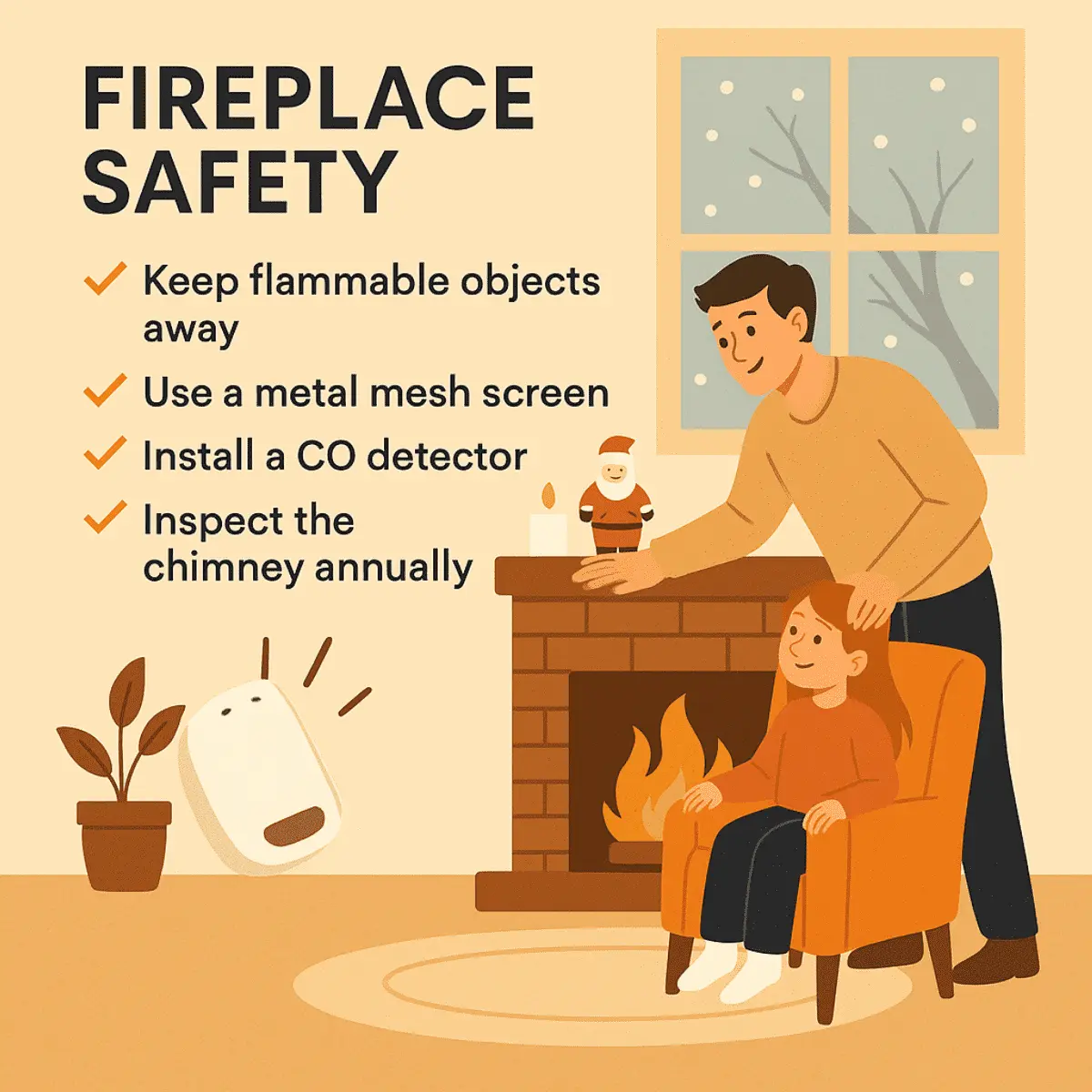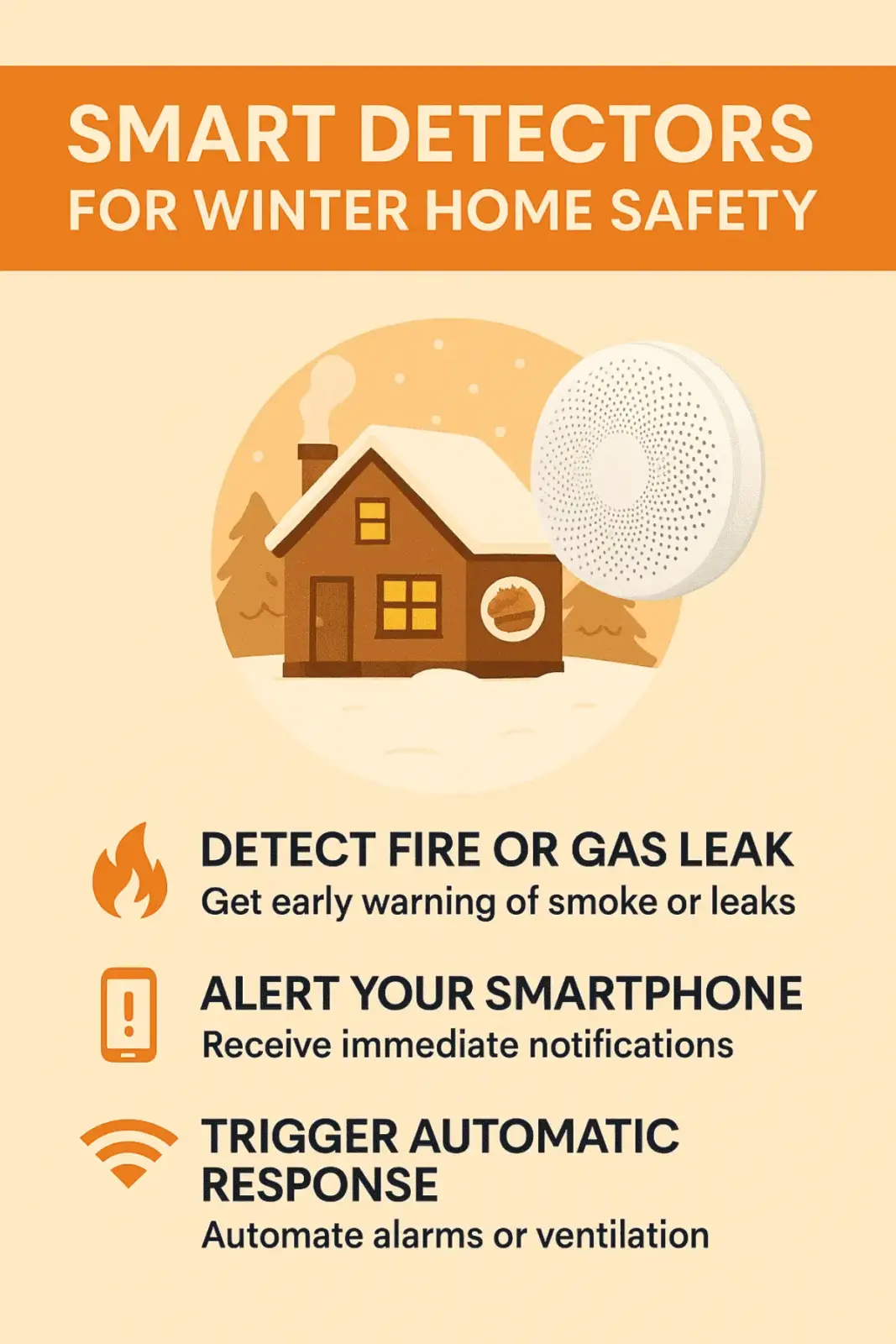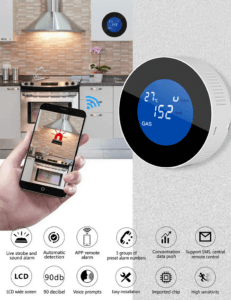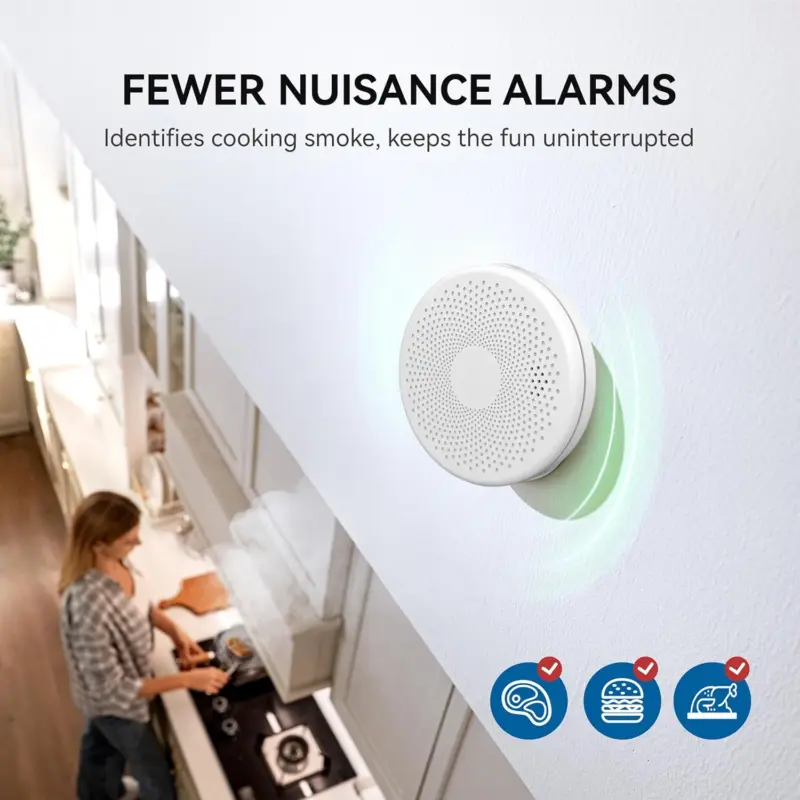Introducción: La calefacción confortable puede ocultar graves riesgos.
A medida que las temperaturas bajan y la nieve cubre los tejados, el encanto de un resplandorhogaro el reconfortante zumbido de uncalentador de aceitese vuelve irresistible. En toda Norteamérica y Europa, cada vez más propietarios están redescubriendo la calidez dechimeneas de leña, petróleo y tradicionales— celebrando tanto la sostenibilidad como la nostalgia.
Sin embargo, tras esta atmósfera acogedora se esconde una amenaza silenciosa.
Los sistemas de calefacción mal ventilados pueden liberarmonóxido de carbono (CO),gases tóxicos, ypartículas finas de humoque se acumulan en el interior, poniendo en peligro la salud de su familia.
Según elCentros para el Control y la Prevención de Enfermedades de EE. UU. (CDC), más queCada año mueren 400 estadounidenses.por intoxicación accidental por CO, siendo los meses de invierno los más peligrosos. Del mismo modo,NFPA (Asociación Nacional de Protección contra Incendios)informes indican que el equipo de calefacción es elsegunda causa principalde incendios domésticos.
Así que, aunque ese fuego rugiente resulte nostálgico, turutina de calefacción de inviernonecesita un aliado moderno: dispositivos de seguridad inteligentes quevigilar, detectar y alertarantes de que el peligro aceche.
Los peligros ocultos tras la calefacción de invierno
Incluso los métodos de calefacción más tradicionales pueden ocultar peligros actuales. Analicémoslos:
1. Combustión incompleta = Monóxido de carbono
Cuando la madera o el petróleo arden sin suficiente oxígeno, se producemonóxido de carbono (CO)— un gas incoloro e inodoro que puede ser mortal en cuestión de minutos.
Una ventilación deficiente o chimeneas parcialmente obstruidas aumentan aún más el riesgo, especialmente cuando las ventanas y puertas están herméticamente selladas en invierno.
Advertencia:No puedes ver ni oler el CO. Solo unDetector de COpuede identificarlo a tiempo.
2. Fugas en calderas de gasóleo y calentadores de gas
Los sistemas de calefacción a base de petróleo pueden desarrollarfugas de combustible o de escape, mientras que los calentadores de gas corren riesgometano o propanoEl agua puede escapar a través de juntas desgastadas o conexiones sueltas. Incluso una pequeña fuga en un espacio confinado puede provocar náuseas, fatiga o riesgo de explosión.
3. Obstrucciones en la chimenea y el conducto de ventilación
La acumulación de creosota en el interior de las chimeneas y los conductos de humos restringe el flujo de aire, forzando la salida del humo y los gases.de vuelta a tu casa.
En las casas antiguas, los animales o los nidos en los conductos de ventilación también pueden causarborrador inverso— una causa común de incidentes con CO.
4. Las cifras que respaldan el riesgo
- Más de 50.000 casos de intoxicación por COtratados anualmente en salas de urgencias de EE. UU.
- 1 de cada 5 propietarios de chimeneano se prueban regularmente las alarmas de CO (encuesta de la NFPA, 2024).
- 80% de los incidentes relacionados con la calefacción de gasóleoestán relacionadas con una ventilación deficiente o un mantenimiento tardío.
Estas estadísticas ponen de manifiesto una verdad clara:La calefacción tradicional debe evolucionar con las modernas tecnologías de seguridad.
Cómo los detectores inteligentes te mantienen seguro

La mejor manera de proteger tu hogar no es solo la prevención, sino tambiéndetección temprana.
Dispositivos de seguridad inteligentes modernos como elGrus GasNet Serieproporcionarmonitoreo continuo del aire, alertas automáticas e incluso respuestas en tiempo real cuando se detectan gases peligrosos o humo.
Los detectores inteligentes combinantecnología multisensor,comunicación inalámbrica, yautomatización basada en la nubepara formar un ecosistema de seguridad completo:
- Detección:Los sensores incorporados miden continuamente los niveles de monóxido de carbono, gas natural y humo.
- Análisis de datos:El sistema compara las lecturas con umbrales dinámicos, ajustándose a la humedad, la temperatura y la presión atmosférica.
- Acción y notificación:Cuando se detectan gases o humo anormales, el detector:
- Activa las alarmas locales (zumbador + LED)
- Envía instantáneamentealertas de teléfonos inteligentesa través de la aplicación Grus
- Activa los dispositivos conectados (por ejemplo, ventiladores, válvulas o luces de emergencia).
- Integración de sistemas:El ecosistema de seguridad inteligente Grus funciona a la perfección conAquaNet válvulas de aguaandDetectores GasNet-CM, ofreciendoapagado automáticopara evitar una escalada.
Ecosistema de seguridad de calefacción inteligente
--- title: "Smart Heating Safety Ecosystem — Enhanced · Horizontal" --- graph LR %% ===== Styles (High Contrast) ===== classDef source fill:#FFEACC,stroke:#E67E22,stroke-width:2,rx:10,ry:10,color:#6E2C00,font-weight:bold; classDef sensor fill:#FFEBEE,stroke:#C62828,stroke-width:2,rx:10,ry:10,color:#7B1C1C,font-weight:bold; classDef hub fill:#E8EAF6,stroke:#3949AB,stroke-width:2,rx:10,ry:10,color:#1A237E,font-weight:bold; classDef alert fill:#E3F2FD,stroke:#1565C0,stroke-width:2,rx:10,ry:10,color:#0D47A1,font-weight:bold; classDef action fill:#E8F5E9,stroke:#2E7D32,stroke-width:2,rx:10,ry:10,color:#1B5E20,font-weight:bold; classDef user fill:#F3E5F5,stroke:#6A1B9A,stroke-width:2,rx:10,ry:10,color:#311B92,font-weight:bold; classDef opt fill:#FFF3D6,stroke:#E69A00,stroke-width:2,rx:10,ry:10,color:#5D3B00,font-weight:bold; %% ===== Main Line (Left -> Right) ===== A["🔥 Heating Source<br/>(Fireplace / Oil / Wood)"]:::source H["🧩 Local Safety Hub<br/>(Edge Logic · Battery Backup)"]:::hub C["📢 Smart Alert System"]:::alert D["⚙️ Auto Safety Response"]:::action E["📱 User App Alert + 🔊 Voice Alarm"]:::user A --> H --> C --> D --> E %% ===== Parallel: Sensor Inputs ===== %% Branches feeding into the Hub S1["🧪 CO Sensor"]:::sensor --> H S2["💨 Smoke Sensor"]:::sensor --> H S3["🛢️ Gas Leak Sensor"]:::sensor --> H S4["🌡️ Temp/Env Sensor"]:::sensor --> H %% ===== Parallel: Response Actions ===== %% Actions driven by the Response stage D --> R1["🧯 Shutoff Valve"]:::action D --> R2["🌀 Ventilation Fan"]:::action D --> R3["🔒 HVAC Cutoff / Damper"]:::action %% ===== Optional & Feedback ===== X["📞 Emergency Call (911 / Security)"]:::opt L["🗂️ Event Log / Maintenance Ticket"]:::opt C -. "Escalation" .-> X C --> L D --> L E -. "Manual Override / Reset" .-> D %% Link style linkStyle default stroke:#555,stroke-width:1.6;
Este enfoque interconectado garantiza que cuando surja el peligro —incluso de noche o lejos de casa— su sistema puedereaccionar automáticamente, deteniendo fugas de gas o activando la ventilación antes de que se produzcan daños.
Lista de verificación de seguridad para la calefacción de invierno
Una lista de verificación proactiva puede ayudarle a prevenir el 90% de los riesgos relacionados con la calefacción en invierno.
| Paso de seguridad | Descripción |
|---|---|
| Comprobar la ventilación mensualmente | Asegúrese de que las chimeneas, los conductos de ventilación y los conductos de humos estén libres de obstrucciones. |
| Instalar detectores de CO y gas | Coloque los detectores cerca de chimeneas, calderas de gasoil y dormitorios. |
| Nunca obstruyas las entradas de aire | Mantenga el flujo de aire para evitar la acumulación de presión negativa. |
| Limpie la chimenea con regularidad. | Elimine las cenizas y el hollín para mejorar la combustión y el flujo de aire. |
| Prueba de alarma semanal | Verifique que el WiFi, los sensores y los zumbadores funcionen correctamente. |
💡Consejo:Comparte esta lista de verificación con familiares o inquilinos y configura recordatorios mensuales en tu aplicación de hogar inteligente.
📌 Esta tabla también se puede compartir visualmente como unaPinterest “Lista de verificación de seguridad para chimeneas”Infografía para promover la concienciación.
Alertas en tiempo real que salvan vidas
detectores modernos comoGasNet-CMandGasNet-SConéctate directamente a tu smartphone.
Recibirásnotificaciones instantáneasif:
- La concentración de CO supera los límites de seguridad.
- Se detecta humo cuando no estás.
- El sistema detecta un desequilibrio en la presión del aire que podría provocar un retroceso de llama.
Elegir el dispositivo de seguridad inteligente adecuado
Los detectores inteligentes vienen en diferentes configuraciones, cada una diseñada para situaciones de calefacción específicas. Aquí te explicamos cómo elegir el adecuado para tu hogar este invierno:
| Guión | Dispositivo recomendado | Beneficio |
|---|---|---|
| Chimenea / Estufa de leña | GasNet-CM | Doble protección contraCO + Humo, ideal para zonas de combustión de madera. |
| Calentador de cocina/gas | GasNet-S4 | Alta sensibilidaddetección de fugas de gas, apto para GLP y gas natural. |
| Monitoreo de toda la casa | Combo de la serie GasNet | Protección unificada para varias habitaciones; integración completa con la aplicación inteligente Grus. |
🛠️ Todos los detectores Grus incluyenConectividad WiFi,Batería de respaldo, ycalibración inteligentepara garantizar datos precisos y en tiempo real incluso en entornos fluctuantes.
Extra: Cómo integrarlo con sistemas domésticos inteligentes

La seguridad de tu hogar no debería existir de forma aislada; debería serconectado, receptivo y automatizado.
Con los dispositivos de seguridad inteligentes Grus, puede conectar fácilmente su sistema de seguridad de calefacción con las principales plataformas de hogar inteligente:
✅ Plataformas compatibles
- Asistente de hogar– Crea automatizaciones personalizadas como: “Si CO > 50 ppm → encender el extractor + enviar notificación push”.
- Alexa / Google Home– Control por voz para comprobaciones de estado en tiempo real: “Alexa, ¿mi chimenea es segura ahora mismo?”
- Grus Nube + AquaNet Integración– Para una automatización de seguridad total:
- Si se detecta una fuga de gas →válvula principal de cierre automático.
- Si el humo persiste →Se activan la ventilación y las luces de alarma.
--- title: "Smart Heating Safety Integration Workflow" --- graph TD; A["CO or Gas Detected"] --> B["Grus Smart App Alert"]; B --> C["Trigger AquaNet Valve"]; B --> D["Activate Exhaust Fan"]; B --> E["Send Alexa/Google Home Notification"];
Este ecosistema transforma tu hogar en unentorno de autoprotección, respondiendo a las emergencias más rápido que cualquier acción manual.
Información sobre la instalación inteligente
Incluso los mejores dispositivos necesitan una instalación correcta para funcionar eficazmente.
1. Consejos de colocación
- MontarDetectores de CO y otros gasesa la altura de la respiración — aproximadamente 1,5 metros por encima del suelo.
- Mantenerdetectores de humocerca del techo, al menos a 3 pies de las rejillas de ventilación.
- Evite instalar detectores directamente encima de chimeneas o quemadores de aceite.
2. Configuración de la conexión
- Empareja cada detector con elGrus Aplicación inteligentepara la monitorización centralizada.
- Permitirnotificaciones en tiempo realy establecer umbrales (por ejemplo, CO > 30 ppm).
- Forviviendas multizona, vincular todos los detectores para recibir alertas sincronizadas.
3. Rutina de mantenimiento
- Pruebe las alarmas semanalmente.
- Reemplace las baterías anualmente.
- Realice la calibración del sensor cada 12 meses (guiado por la aplicación).
Conclusión: Hagamos de este invierno un invierno seguro e inteligente
Un hogar cálido nunca debería conllevar riesgos ocultos.
Ya sea que utilice una chimenea, un calentador de aceite o una estufa de leña, las amenazas invisibles —monóxido de carbono, humo y fugas de gas— puede ser tan peligroso como el frío helado.
Al combinarGrus GasNet detectores inteligentescontermostatos EcoNetandAquaNet válvulas de seguridad, puedes crear unred de seguridad de calefacción totalmente inteligenteque protege a tu familia día y noche.
🔒Manténgase cómodo, manténgase seguro y haga de este invierno el más inteligente hasta ahora.
🌐 Explora elGrus Serie de seguridad inteligentehoy a lasgrus.io.

